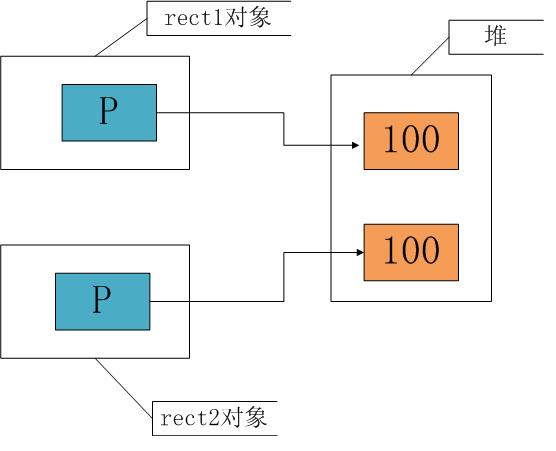C++拷贝构造函数详解
2016-05-17 17:35
741 查看
本文转载自C++拷贝构造函数详解
一. 什么是拷贝构造函数
对于普通类型的对象来说,它们之间的复制是很简单的。

从以上代码的运行结果可以看出,系统为对象B分配了内存并完成了与对象A的复制过程。就类对象而言,相同类型的类对象是通过拷贝构造函数来完成整个复制过程的。下面举例说明拷贝构造函数的工作过程。

CExample(const CExample& C)就是我们自定义的拷贝构造函数。可见,拷贝构造函数是一种特殊的构造函数,函数的名称必须和类名称一致,它必须的一个参数是本类型的一个引用变量。
二. 拷贝构造函数的调用时机
在C++中,下面三种对象需要调用拷贝构造函数。
1. 对象以值传递的方式传入函数参数

调用g_Fun()时,会产生以下几个重要步骤:
(1)test对象传入形参时产生一个临时变量temp。
(2)调用拷贝构造函数把test的值给temp。
(3)等g_Fun()执行完后析构掉temp对象。
2. 对象以值传递的方式从函数返回

当g_Fun()执行到return时,会产生以下几个重要步骤:
(1)产生一个临时变量temp。
(2)调用拷贝构造函数把test的值给temp。
(3)在函数执行到最后先析构test局部变量。
(4)等g_Fun()执行完后再析构掉temp对象。
3. 对象需要通过另外一个对象进行初始化
三. 浅拷贝和深拷贝
1. 默认拷贝构造函数
很多时候在我们都不知道拷贝构造函数的情况下,传递对象给函数参数或者函数返回对象都能很好的进行,这是因为编译器会给我们自动产生一个拷贝构造函数,这就是默认拷贝构造函数。这个构造函数很简单,仅仅使用老对象的数据成员的值对新对象的数据成员一一进行赋值,它一般具有下面形式。

这段代码对前面的类加入了一个静态成员,目的是进行计数。在主函数中,首先创建对象rect1,输出此时的对象个数,然后使用rect1复制出对象rect2,再输出此时的对象个数。按照理解,此时应该有两个对象存在,但实际程序运行时,输出的都是1,反应出只有1个对象。此外,在销毁对象时,由于会销毁两个对象,类的析构函数会调用两次,此时的计数器将变为负数。说白了,就是拷贝构造函数没有处理静态数据成员。出现这些问题最根本就在于在复制对象时,计数器没有递增。

2. 浅拷贝
所谓浅拷贝,指的是在对象复制时,只对对象中的数据成员进行简单的赋值,默认拷贝构造函数执行的也是浅拷贝。大多情况下浅拷贝已经能很好地工作了,但是一旦对象存在了动态成员,浅拷贝就会出问题了。
执行赋值后的内存情况如下:

当然,这不是我们所期望的结果。在销毁对象时,两个对象的析构函数将对同一个内存空间释放两次,这就是错误出现的原因。我们需要的不是两个p有相同的值,而是两个p指向的空间有相同的值,解决办法就是使用深拷贝。
3. 深拷贝
在深拷贝的情况下,对于对象中动态成员,就不能仅仅简单地赋值了,而应该重新动态分配空间,如上面的例子就应该按照下面的方式进行处理。

此时rect1的p和rect2的p各自指向一段内存空间,但它们指向的空间具有相同的内容,这就是所谓的深拷贝。
4. 防止默认拷贝发生
通过对对象复制的分析,我们发现对象的复制大多在进行值传递时发生,这里有一个小技巧可以防止按值传递——声明一个私有拷贝构造函数。甚至不必去定义这个拷贝构造函数,这样因为拷贝构造函数是私有的,如果用户试图按值传递或函数返回该类对象,将得到一个编译错误,从而可以避免按值传递或返回对象。
1. 拷贝构造函数里能调用private成员变量吗?
解答:这个问题是在网上见的,当时一下子有点晕。其时从名子我们就知道拷贝构造函数其实就是一个特殊的构造函数,操作的还是自己类的成员变量,所以不受private的限制。
2. 以下函数哪个是拷贝构造函数,为什么?
解答:对于一个类X,如果一个构造函数的第一个参数是下列之一:
a) X&
b) const X&
c) volatile X&
d) const volatile X&
且没有其他参数或其他参数都有默认值,那么这个函数是拷贝构造函数。
3. 一个类中可以存在多于一个的拷贝构造函数吗?
解答:类中可以存在超过一个拷贝构造函数。如果一个类中只存在一个参数为 X& 的拷贝构造函数,那么就不能使用const X或volatile X的对象实行拷贝初始化。如果一个类中没有定义拷贝构造函数,那么编译器会自动产生一个默认的拷贝构造函数。这个默认的参数可能为 X::X(const X&)或 X::X(X&),由编译器根据上下文决定选择哪一个。
一. 什么是拷贝构造函数
对于普通类型的对象来说,它们之间的复制是很简单的。
int a=100; int b=a;而类对象与普通对象不同,类对象内部结构一般较为复杂,存在各种成员变量。下面看一个类对象拷贝的简单例子。
#include<iostream>
using namespace std;
class CExample
{
private:
int a;
public:
CExample(int b)
{
a=b;
}
void Show()
{
cout<<a<<endl;
}
};
int main()
{
CExample A(100);
CExample B=A;
B.Show();
}
从以上代码的运行结果可以看出,系统为对象B分配了内存并完成了与对象A的复制过程。就类对象而言,相同类型的类对象是通过拷贝构造函数来完成整个复制过程的。下面举例说明拷贝构造函数的工作过程。
#include<iostream>
using namespace std;
class CExample
{
private:
int a;
public:
CExample(int b)
{
a=b;
}
CExample(const CExample& C)
{
a=C.a;
}
void Show()
{
cout<<a<<endl;
}
};
int main()
{
CExample A(100);
CExample B=A;
B.Show();
}
CExample(const CExample& C)就是我们自定义的拷贝构造函数。可见,拷贝构造函数是一种特殊的构造函数,函数的名称必须和类名称一致,它必须的一个参数是本类型的一个引用变量。
二. 拷贝构造函数的调用时机
在C++中,下面三种对象需要调用拷贝构造函数。
1. 对象以值传递的方式传入函数参数
#include<iostream>
using namespace std;
class CExample
{
private:
int a;
public:
CExample(int b)
{
a=b;
cout<<"creat: "<<a<<endl;
}
CExample(const CExample& C)
{
a=C.a;
cout<<"copy"<<endl;
}
~CExample()
{
cout<< "delete: "<<a<<endl;
}
void Show()
{
cout<<a<<endl;
}
};
void g_Fun(CExample C)
{
cout<<"test"<<endl;
}
int main()
{
CExample test(1);
g_Fun(test);
}
调用g_Fun()时,会产生以下几个重要步骤:
(1)test对象传入形参时产生一个临时变量temp。
(2)调用拷贝构造函数把test的值给temp。
(3)等g_Fun()执行完后析构掉temp对象。
2. 对象以值传递的方式从函数返回
#include<iostream>
using namespace std;
class CExample
{
private:
int a;
public:
CExample(int b)
{
a=b;
cout<<"creat: "<<a<<endl;
}
CExample(const CExample& C)
{
a=C.a;
cout<<"copy"<<endl;
}
~CExample()
{
cout<<"delete: "<<a<<endl;
}
void Show()
{
cout<<a<<endl;
}
};
CExample g_Fun()
{
CExample test(1);
return test;
}
int main()
{
g_Fun();
}
当g_Fun()执行到return时,会产生以下几个重要步骤:
(1)产生一个临时变量temp。
(2)调用拷贝构造函数把test的值给temp。
(3)在函数执行到最后先析构test局部变量。
(4)等g_Fun()执行完后再析构掉temp对象。
3. 对象需要通过另外一个对象进行初始化
CExample A(100); CExample B=A; CExample B(A);后两句都会调用拷贝构造函数。
三. 浅拷贝和深拷贝
1. 默认拷贝构造函数
很多时候在我们都不知道拷贝构造函数的情况下,传递对象给函数参数或者函数返回对象都能很好的进行,这是因为编译器会给我们自动产生一个拷贝构造函数,这就是默认拷贝构造函数。这个构造函数很简单,仅仅使用老对象的数据成员的值对新对象的数据成员一一进行赋值,它一般具有下面形式。
Rect::Rect(const Rect& r)
{
width=r.width;
height=r.height;
}当然,以上代码不用我们编写,编译器会为我们自动生成。但是如果认为这样就可以解决对象的复制问题,那就错了。#include<iostream>
using namespace std;
class Rect
{
public:
Rect()
{
count++;
}
~Rect()
{
count--;
}
static int getCount()
{
return count;
}
private:
int width;
int height;
static int count;
};
int Rect::count=0;
int main()
{
Rect rect1;
cout<<"The count of Rect: "<<Rect::getCount()<<endl;
Rect rect2(rect1);
cout<<"The count of Rect: "<<Rect::getCount()<<endl;
}
这段代码对前面的类加入了一个静态成员,目的是进行计数。在主函数中,首先创建对象rect1,输出此时的对象个数,然后使用rect1复制出对象rect2,再输出此时的对象个数。按照理解,此时应该有两个对象存在,但实际程序运行时,输出的都是1,反应出只有1个对象。此外,在销毁对象时,由于会销毁两个对象,类的析构函数会调用两次,此时的计数器将变为负数。说白了,就是拷贝构造函数没有处理静态数据成员。出现这些问题最根本就在于在复制对象时,计数器没有递增。
#include<iostream>
using namespace std;
class Rect
{
public:
Rect()
{
count++;
}
Rect(const Rect& r)
{
width=r.width;
height=r.height;
count++;
}
~Rect()
{
count--;
}
static int getCount()
{
return count;
}
private:
int width;
int height;
static int count;
};
int Rect::count=0;
int main()
{
Rect rect1;
cout<<"The count of Rect: "<<Rect::getCount()<<endl;
Rect rect2(rect1);
cout<<"The count of Rect: "<<Rect::getCount()<<endl;
}
2. 浅拷贝
所谓浅拷贝,指的是在对象复制时,只对对象中的数据成员进行简单的赋值,默认拷贝构造函数执行的也是浅拷贝。大多情况下浅拷贝已经能很好地工作了,但是一旦对象存在了动态成员,浅拷贝就会出问题了。
#include<iostream>
using namespace std;
class Rect
{
public:
Rect()
{
p=new int(100);
}
~Rect()
{
if(p!=NULL)
{
delete p;
}
}
private:
int width;
int height;
int *p;
};
int main()
{
Rect rect1;
Rect rect2(rect1);
}执行赋值后的内存情况如下:

当然,这不是我们所期望的结果。在销毁对象时,两个对象的析构函数将对同一个内存空间释放两次,这就是错误出现的原因。我们需要的不是两个p有相同的值,而是两个p指向的空间有相同的值,解决办法就是使用深拷贝。
3. 深拷贝
在深拷贝的情况下,对于对象中动态成员,就不能仅仅简单地赋值了,而应该重新动态分配空间,如上面的例子就应该按照下面的方式进行处理。
#include<iostream>
using namespace std;
class Rect
{
public:
Rect()
{
p=new int(100);
}
Rect(const Rect& r)
{
width=r.width;
height=r.height;
p=new int;
*p=*(r.p);
}
~Rect()
{
if(p!=NULL)
{
delete p;
}
}
private:
int width;
int height;
int *p;
};
int main()
{
Rect rect1;
Rect rect2(rect1);
}执行赋值后的内存情况如下:
此时rect1的p和rect2的p各自指向一段内存空间,但它们指向的空间具有相同的内容,这就是所谓的深拷贝。
4. 防止默认拷贝发生
通过对对象复制的分析,我们发现对象的复制大多在进行值传递时发生,这里有一个小技巧可以防止按值传递——声明一个私有拷贝构造函数。甚至不必去定义这个拷贝构造函数,这样因为拷贝构造函数是私有的,如果用户试图按值传递或函数返回该类对象,将得到一个编译错误,从而可以避免按值传递或返回对象。
#include<iostream>
using namespace std;
class CExample
{
private:
int a;
CExample(const CExample& C);
public:
CExample(int b)
{
a=b;
cout<<"creat: "<<a<<endl;
}
~CExample()
{
cout<< "delete: "<<a<<endl;
}
void Show()
{
cout<<a<<endl;
}
};
void g_Fun(CExample C)
{
cout<<"test"<<endl;
}
int main()
{
CExample test(1);
//g_Fun(test); 按值传递将出错
}四. 拷贝构造函数的几个细节1. 拷贝构造函数里能调用private成员变量吗?
解答:这个问题是在网上见的,当时一下子有点晕。其时从名子我们就知道拷贝构造函数其实就是一个特殊的构造函数,操作的还是自己类的成员变量,所以不受private的限制。
2. 以下函数哪个是拷贝构造函数,为什么?
X::X(const X&); X::X(X); X::X(X&,int a=1); X::X(X&,int a=1,int b=2);
解答:对于一个类X,如果一个构造函数的第一个参数是下列之一:
a) X&
b) const X&
c) volatile X&
d) const volatile X&
且没有其他参数或其他参数都有默认值,那么这个函数是拷贝构造函数。
3. 一个类中可以存在多于一个的拷贝构造函数吗?
解答:类中可以存在超过一个拷贝构造函数。如果一个类中只存在一个参数为 X& 的拷贝构造函数,那么就不能使用const X或volatile X的对象实行拷贝初始化。如果一个类中没有定义拷贝构造函数,那么编译器会自动产生一个默认的拷贝构造函数。这个默认的参数可能为 X::X(const X&)或 X::X(X&),由编译器根据上下文决定选择哪一个。
相关文章推荐
- C++类内存实验(一)
- C++——成员函数
- c++ 之replace函数用法
- C语言高级知识点滴
- POJ 3254 Corn Fields(状态压缩DP)
- C语言编写金字塔
- c++ inline 函数
- c语言文件操作总结
- c语言写的数据挖掘的层次聚类算法(新手版)
- [C++] 构造/析构/赋值运算
- C++ Builder 学习1
- Symbain同时支持C++开发和Java开发
- C++ 成员运算符(. 和 ->)
- C++单例模式的最实用写法
- c++中vector的用法详解
- C++格式化输出,C++输出格式控制
- C++输入cout与输出cin
- C++的const类成员函数
- C语言面试的几道题。
- vs上C/C++并行计算#pragma omp
